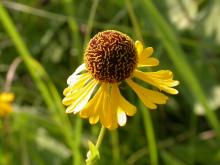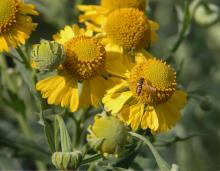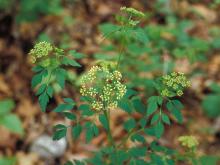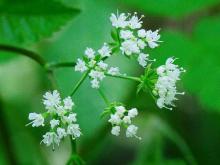Wildflowers, Grasses and Other Nonwoody Plants
Media

Species Types
Scientific Name
Viola pubescens (formerly V. pensylvanica)
Description
The yellow violet is Missouri's only all-yellow violet. This native wildflower is less common than violet violets. Look for it in low woods, rich slopes, and wooded floodplains.
Media

Species Types
Scientific Name
Ranunculus hispidus
Description
Hispid buttercup is a densely hairy plant with showy yellow flowers. It is found mostly in the southern half of Missouri, usually in moist locations.
Media

Species Types
Scientific Name
Cirsium altissimum
Description
Tall thistle is a native thistle that can grow to be 10 feet tall! To identify it, notice its leaves, which are unlobed (though they may be wavy or have only shallow, broad lobes), are felty-hairy beneath, and have prickles only along the edges.
Media

Species Types
Scientific Name
Pedicularis canadensis
Description
Wood betony has a tight spiral of tubular, hooded yellow flowers atop a plant adorned with deeply incised, fernlike leaves that are about as attractive as the flowers themselves. In early spring, these leaves have a beautiful wine-red coloration.
Media

Species Types
Scientific Name
Helenium flexuosum
Description
The purplish or brownish disk florets of purple-headed sneezeweed set it apart from our other sneezeweeds, whose centers are yellow. Look for it in moist, open areas, mostly in the southern half of the state.
Media

Species Types
Scientific Name
Elephantopus carolinianus
Description
You may not recognize elephant’s foot as a member of the daisy or sunflower family because it lacks petal-like ray florets. Also, it has unusual, doubly compound flower clusters. And how did it get its name, anyway?
Media

Species Types
Scientific Name
Helenium autumnale
Description
Autumn sneezeweed is a late-blooming perennial with conspicuously winged stems. The flowerheads have yellow, domed disks. The ray flowers are fan-shaped, yellow, and notched.
Media

Species Types
Scientific Name
Zizia aurea
Description
Named for its resemblance to a European herb that was popular in Medieval times, golden Alexanders is a native Missouri wildflower with bright yellow flowers arranged in umbrella-like clusters.
Media

Species Types
Scientific Name
Osmorhiza claytonii and O. longistylis
Description
Missouri has two species of sweet cicely, which can be hard to tell apart. Both have umbels of small white flowers, fernlike leaves, and sweetly aromatic, carrotlike roots.
Media

Species Types
Scientific Name
All true grasses (species in the grass family)
Description
Missouri has 276 species in the grass family, including well-known crop plants and our native prairie grasses. Distinguishing between the species can be difficult, but it’s easy to learn some basics about the group.
See Also
About Wildflowers, Grasses and Other Nonwoody Plants in Missouri
A very simple way of thinking about the green world is to divide the vascular plants into two groups: woody and nonwoody (or herbaceous). But this is an artificial division; many plant families include some species that are woody and some that are not. The diversity of nonwoody vascular plants is staggering! Think of all the ferns, grasses, sedges, lilies, peas, sunflowers, nightshades, milkweeds, mustards, mints, and mallows — weeds and wildflowers — and many more!





















